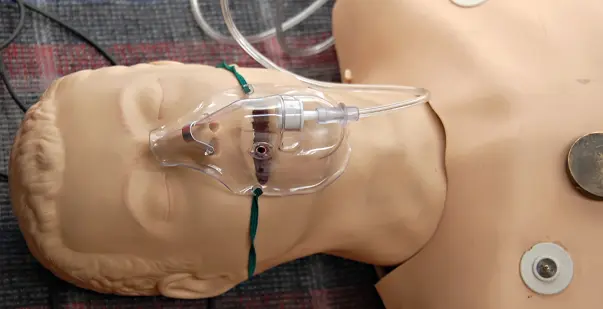Table of content(s)
- Introduction
- What are the uses of oxygen?
- Understanding the interactions of oxygen
- Mechanism of action for oxygen
- Conclusion
Oxygen is administered to patients with respiratory issues to ensure adequate oxygen levels in the blood. This is critical for conditions such as asthma and several other health conditions.
It is crucial to understand the interactions of oxygen for effective use. Oxygen therapy must be monitored carefully when used with respiratory depressants. This helps prevent complications. In this blog, let us assess the classification of oxygen, interactions, and mechanisms of action of oxygen.
Master ACLS Now
Get ACLS certified with confidence
What are the uses of oxygen?
Here are a few uses of oxygen:
-
Respiratory conditions:
- Chronic obstructive pulmonary disease (COPD): Patients with COPD experience difficulty breathing due to obstructed airflow. Supplemented oxygen helps maintain adequate oxygen levels in the blood. It improves overall health and quality of life.
- Asthma: During asthma attacks, oxygen therapy can reduce symptoms by offering immediate relief from hypoxia.
- Pneumonia: Oxygen therapy helps improve oxygenation and reduces the workload on the lines and the heart.
-
Acute medical situations:
- Heart attack: During a heart attack, the heart muscle does not have oxygen. Administering oxygen can reduce the damage to the heart tissue.
- Stroke: You can use oxygen therapy in the acute phase of a stroke. This helps ensure the brain receives adequate oxygen and minimizes brain damage.
- Trauma: During trauma, such as head injuries, oxygen drugs and therapy support the body’s vital functions during critical care.
-
Chronic diseases:
- Congestive heart failure: Oxygen therapy can reduce symptoms and improve the quality of life in patients with heart failure. This helps ensure the tissues receive optimum oxygen.
- Cystic fibrosis: Oxygen therapy helps patients with cystic fibrosis. This reduces the burden on their compromised respiratory systems.
-
Anesthesia and surgery:
- Pre- and post-operative care: Oxygen is used before, during, and after surgery to maintain proper oxygenation levels. It reduces the risk of hypoxia while promoting healing.
- Anesthesia: During administering anesthesia, oxygen ensures the patient maintains oxygen levels. This is especially true during procedures that can impair respiratory function.
Read More: Principles of early defibrillation
Understanding the interactions of oxygen
Oxygen interacts with various medications and treatments, which can influence patient care. These interventions are critical for the safety administering oxygen therapy:
- Medication: Oxygen can mitigate the effects of certain drugs. For example, it can intensify the impact of aesthetics, necessitating careful monitoring during surgical procedures. When it is used with respiratory depressants such as sedatives, you must manage oxygen therapy to avoid aggravating the respiratory depression.
- Chronic conditions: In patients with chronic obstructive pulmonary disease, administering oxygen can reduce the drive to breathe. It leads to hypercapnia. Hence, it is essential to precisely control oxygen therapy for COPD patients.
- Combination therapies: Oxygen is used along with other treatments such as corticosteroids and bronchodilators. This helps manage conditions such as COPD and asthma. The dosage and timing of oxygen relative to medications are vital to avoid effects and minimize therapeutic benefits.
- Hyperbaric oxygen therapy (HBOT): In HBOT, oxygen is delivered at higher than atmospheric pressures. This therapy is effective for conditions including carbon monoxide poisoning and non-healing wounds. You need to be careful of potential interactions with other treatments to avoid complications.
Mechanism of action for oxygen
Oxygen is crucial to cellular respiration. This is vital for energy production in living organisms. Here is an overview of the mechanism of action for oxygen:
-
Inhalation and transport:
- Respiratory system: Oxygen enters the body through the respiratory system when we inhale. It travels down the trachea and reaches the alveoli, tiny air sacs where gas exchange occurs.
- Gas exchange: In the alveoli, oxygen diffuses across the thin membrane in the surrounding capillaries. This enters the bloodstream. It binds to hemoglobin molecules in red blood cells.
-
Circulation:
- Hemoglobin: It is a protein in red blood cells. This carries oxygen from the lungs to tissues throughout the body. The hemoglobin molecule carries up to four oxygen molecules.
- Transportation: Oxygen-rich blood is pumped from the lungs to the heart. This circulates it to the body tissues via the arterial system.
- Cellular utilization: Oxygen is delivered to cells and used in cellular respiration. This process converts glucose and oxygen into adenosine triphosphate.
- Energy production: ATP produced during cellular respiration is vital for various cellular functions, including nerve impulse propagation.
-
Exhalation of byproducts:
Carbon dioxide removal: Carbon dioxide is a waste product of cellular respiration. It diffuses from the cells into the blood, where it is transported back to the lungs. It is exhaled from the body during the breathing process.
Read More: What To Do When Your ACLS Has Expired
Conclusion
So, is oxygen considered a medication? It is administered to prevent and treat low blood oxygen levels. It offers support for respiratory conditions. Oxygen drugs need efficient management to ensure patient safety. Oxygen therapy can improve patient outcomes, which makes it a crucial component of modern healthcare.







